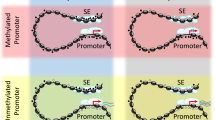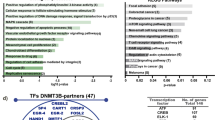Abstract
This study aimed to (a) determine if DNA methylation is a mechanism of WWOX (WW domain containing oxidoreductase) and FHIT (fragile histidine triad) inactivation in lung, breast and bladder cancers; (b) examine distinct methylation patterns in neoplastic and adjacent tissues and (c) seek correlation of methylation patterns with disease status. Protein expression was detected by immunohistochemistry, and methylation status by methylation-specific PCR (MSP) and sequencing, in lung squamous cell carcinomas and adjacent tissues, invasive breast carcinomas, adjacent tissues and normal mammary tissues and bladder transitional cell carcinomas. Wwox and Fhit expression was reduced in cancers in association with hypermethylation. Differential patterns of WWOX and FHIT methylation were observed in neoplastic vs adjacent non-neoplastic tissues, suggesting that targeted MSP amplification could be useful in following treatment or prevention protocols. WWOX promoter MSP differentiates DNA of lung cancer from DNA of adjacent lung tissue. WWOX and FHIT promoter methylation is detected in tissue adjacent to breast cancer and WWOX exon 1 MSP distinguishes breast cancer DNA from DNA of adjacent and normal tissue. Differential methylation in cancerous vs adjacent tissues suggests that WWOX and FHIT hypermethylation analyses could enrich a panel of DNA methylation markers.
This is a preview of subscription content, access via your institution
Access options
Subscribe to this journal
Receive 50 print issues and online access
$259.00 per year
only $5.18 per issue
Buy this article
- Purchase on Springer Link
- Instant access to full article PDF
Prices may be subject to local taxes which are calculated during checkout



Similar content being viewed by others
References
Baffa R, Gomella LG, Vecchione A, Bassi P, Mimori K, Sedor J, Calviello CM, Gardiman M, Minimo C, Strup SE, McCue PA, Kovatich AJ, Pagano F, Huebner K and Croce CM . (2000). Am. J. Pathol., 156, 419–424.
Bednarek AK, Keck-Waggoner CL, Daniel RL, Laflin KJ, Bergsagel PL, Kiguchi K, Brenner AJ and Aldaz CM . (2001). Cancer Res., 61, 8068–8073.
Bednarek AK, Laflin KJ, Daniel RL, Liao Q, Hawkins KA and Aldaz CM . (2000). Cancer Res., 60, 2140–2145.
Driouch K, Prydz H, Monese R, Johansen H, Lidereau R and Frengen E . (2002). Oncogene, 21, 1832–1840.
Esteller M, Hamilton SR, Burger PC, Baylin SB and Herman JG . (1999a). Cancer Res., 59, 793–797.
Esteller M, Sanchez-Cespedes M, Rosell R, Sidransky D, Baylin SB and Herman JG . (1999b). Cancer Res., 59, 67–70.
Gatalica Z, Lele SM, Rampy BA and Norris BA . (2000). Cancer, 88, 1378–1383.
Guler G, Uner A, Guler N, Han SY, Iliopoulos D, Hauck WW, McCue P and Huebner K . (2004). Cancer, 100, 1605–1614.
Hennessy BT, Garcia-Manero G, Kantarjian HM and Giles FJ . (2003). Expert Opin. Invest. Drugs, 12, 1985–1993.
Herman JG, Graff JR, Myohanen S, Nelkin BD and Baylin SB . (1996). Proc. Natl. Acad. Sci. USA, 93, 9821–9826.
Huebner K and Croce CM . (2003). Br. J. Cancer, 88, 1501–1506.
Huebner K, Garrison PN, Barnes LD and Croce CM . (1998). Ann. Rev. Genet., 32, 7–31.
Ingvarsson S, Agnarsson BA, Sigbjornsdottir BI, Kononen J, Kallioniemi OP, Barkardottir RB, Kovatich AJ, Schwarting R, Hauck WW, Huebner K and McCue PA . (1999). Cancer Res., 59, 2682–2689.
Ishii H and Furukawa Y . (2004). Int. J. Hematol., 79, 238–242.
Kim H, Kwon YM, Kim JS, Lee H, Park JH, Shim YM, Han J, Park J and Kim DH . (2004). J. Clin. Oncol., 22, 2363–2370.
Kuroki T, Trapasso F, Shiraishi T, Alder H, Mimori K, Mori M and Croce CM . (2002). Cancer Res., 62, 2258–2260.
Kuroki T, Yendamuri S, Trapasso F, Matsuyama A, Aqeilan RI, Alder H, Rattan S, Cesari R, Nolli ML, Williams NN, Mori M, Kanematsu T and Croce CM . (2004). Clin. Cancer Res., 10, 2459–2465.
Maruyama R, Toyooka S, Toyooka KO, Harada K, Virmani AK, Zochbauer-Muller S, Farinas AJ, Vakar-Lopez F, Minna JD, Sagalowsky A, Czerniak B and Gazdar AF . (2001). Cancer Res., 61, 8659–8663.
McGregor F, Muntoni A, Fleming J, Brown J, Felix DH, MacDonald DG, Parkinson EK and Harrison PR . (2002). Cancer Res., 16, 4757–4766.
Muller HM, Widschwendter A, Fiegl H, Ivarsson L, Goebel G, Perkmann E, Marth C and Widschwendter M . (2003). Cancer Res., 63, 7641–7645.
Ohta M, Inoue H, Cotticelli MG, Kastury K, Baffa R, Palazzo J, Siprashvili Z, Mori M, MuCue P, Druck T, Croce CM and Huebner K . (1996). Cell, 84, 587–597.
Paige AJ, Taylor KJ, Taylor C, Hillier SG, Farrington S, Scott D, Porteous DJ, Smyth JF, Gabra H and Watson JE . (2001). Proc. Natl. Acad. Sci. USA, 98, 11417–11422.
Palmisano WA, Divine KK, Saccomanno G, Gilliland FD, Baylin SB, Herman JG and Belinsky SA . (2000). Cancer Res., 60, 5954.
Sanchez-Cespedes M, Esteller M, Wu L, Nawroz-Danish H, Yoo GH, Koch WM, Jen J, Herman JG and Sidransky D . (2000). Cancer Res., 60, 892–895.
Skopelitou AS, Gloustianou G, Bai M and Huebner K . (2001). In vivo, 15, 169–173.
Soria JC, Rodriguez M, Liu DD, Lee JJ, Hong WK and Mao L . (2000). Cancer Res., 62, 351–355.
Sozzi G, Pastorino U, Moiraghi L, Tagliabue E, Pezzella F, Ghirelli C, Tornielli S, Sard L, Huebner K, Pierotti MA, Croce CM and Pilotti S . (1998). Cancer Res., 58, 5032–5037.
Takai N, Desmond JC, Kumagai T, Gui D, Said JW, Whittaker S, Miyakawa I and Koeffler HP . (2004). Clin. Cancer Res., 10, 1141–1149.
Tanaka H, Shimada Y, Harada H, Shinoda M, Hatooka S, Imamura M and Ishizaki K . (1998). Cancer Res., 58, 3429–3434.
Tang X, Khuri FR, Lee JJ, Kemp BL, Liu D, Hong WK and Mao L . (2000). J. Natl. Cancer Inst., 92, 1511–1516.
Yang Q, Nakamura M, Nakamura Y, Yoshimura G, Suzuma T, Umemura T, Shimizu Y, Mori I, Sakurai T and Kakudo K . (2002). Clin. Cancer Res., 8, 2890–2893.
Yendamuri S, Kuroki T, Trapasso F, Henry AC, Dumon KR, Huebner K, Williams NN, Kaiser LR and Croce CM . (2003). Cancer Res., 63, 878–881.
Zochbauer-Muller S, Fong KM, Maitra A, Lam S, Geradts J, Ashfaq R, Virmani AK, Milchgrub S, Gazdar AF and Minna JD . (2001). Cancer Res., 61, 3581–3585.
Acknowledgements
This work was supported by USPHS grants CA77738, CA56036 and training grant T32-HLO7780 (KAM); also supported by NIH contracts N01-CN-15128 and N01-CN-15113.
Author information
Authors and Affiliations
Corresponding author
Rights and permissions
About this article
Cite this article
Iliopoulos, D., Guler, G., Han, SY. et al. Fragile genes as biomarkers: epigenetic control of WWOX and FHIT in lung, breast and bladder cancer. Oncogene 24, 1625–1633 (2005). https://doi.org/10.1038/sj.onc.1208398
Received:
Revised:
Accepted:
Published:
Issue Date:
DOI: https://doi.org/10.1038/sj.onc.1208398
Keywords
This article is cited by
-
Identification of compound heterozygous deletion of the WWOX gene in WOREE syndrome
BMC Medical Genomics (2023)
-
HDAC6 is a prognostic biomarker that mediates IL-13 expression to regulate macrophage polarization through AP-1 in oral squamous cell carcinoma
Scientific Reports (2022)
-
In vitro and in silico assessment of the effect of WWOX expression on invasiveness pathways associated with AP-2 transcription factors in bladder cancer
BMC Urology (2021)
-
Characterization of WWOX expression and function in canine mast cell tumors and malignant mast cell lines
BMC Veterinary Research (2020)
-
DNA methylation profiles in cancer diagnosis and therapeutics
Clinical and Experimental Medicine (2018)



